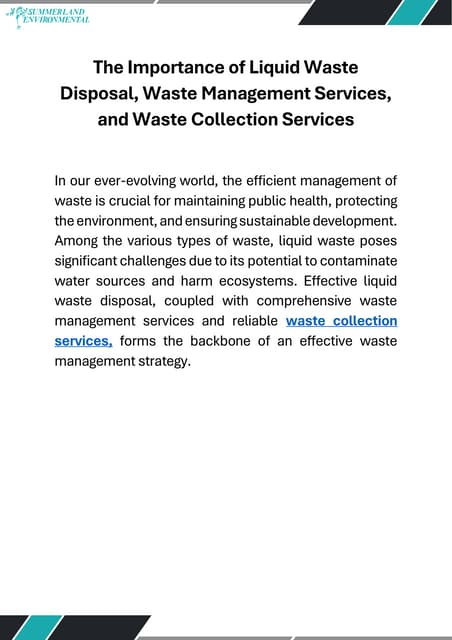Unknown Facts About Reclaim Waste
Unknown Facts About Reclaim Waste
Blog Article
Our Reclaim Waste Diaries
Table of ContentsGetting The Reclaim Waste To WorkThe Basic Principles Of Reclaim Waste Some Known Details About Reclaim Waste The 25-Second Trick For Reclaim WasteRumored Buzz on Reclaim Waste
Domestic sewage waste refers to the waste and products from a household septic tank. The appropriate administration and disposal of residential sewage waste call for liquid waste to be transferred to a sewer therapy plant where the proper techniques and tools are used to purify and dispose of waste.
Business waste often includes prospective risks, such as combustible products or a mix of fluid and solid waste items, and needs a much more advanced and detailed disposal procedure. The disposal of commercial waste usually includes the purification of waste prior to transportation to make sure safe and appropriate disposal. Industrial waste is developed from byproducts and overflow of commercial processes and production.
This type of waste can not make use of the same sewer administration transportation or processes as septic or commercial fluids. The hazardous waste monitoring process needs the inspection and screening of liquid waste before it goes through the disposal process (industrial wastewater treatment). Overflow waste is the fluid waste that originates from overflow and excess stormwater in highly populated locations or cities
Runoff waste can cause contamination and flooding otherwise taken care of appropriately. Learn much more regarding sewer cleaning and waste monitoring. Making certain appropriate waste administration can prevent disasters and decrease environmental harm. Both people in domestic setups and professionals in commercial or manufacturing markets can benefit from recognizing the processes and policies of fluid waste administration.
The 30-Second Trick For Reclaim Waste
Contact PROS Services today to discover about our waste monitoring and disposal solutions and the appropriate ways to take care of the fluid waste you produce.
(https://fliphtml5.com/homepage/kekhp)Do you know what takes place to your water when you end, purge the commode or drain the washing maker? No? Well, it's worth understanding. This supposed 'wastewater' is not only a vital resource but, after treatment, will be released to our land, waterways or the sea. Made use of water from bathrooms, showers, bathrooms, kitchen sinks, washings and commercial processes is called wastewater.

water utilized to cool equipment or tidy plant and equipment). Stormwater, a type of wastewater, is overflow that moves from farming and city areas such as roof coverings, parks, gardens, roadways, paths and seamless gutters right into stormwater drains, after rainfall. Stormwater moves without treatment directly to neighborhood creeks or rivers, eventually getting to the sea.
Reclaim Waste Things To Know Before You Get This
In Queensland, the majority of wastewater is treated at sewage therapy plants. Wastewater is transferred from domestic or industrial sites via a system of sewers and pump stations, called sewage reticulation, to a sewer therapy plant. City governments construct, keep and run most sewage treatment plants. Operators are certified under the Environmental Management Act 1994 to discharge treated wastewater at an acceptable environmental standard right into rivers.
The Department of Natural Resources advises neighborhood federal governments regarding managing, operating and maintaining sewage systems and therapy plants. In unsewered areas, city governments may need owners to set up specific or family sewer treatment systems to deal with residential wastewater from toilets, kitchens, washrooms and washings. The Division of Natural Resources authorises the use of house systems when they are verified to be efficient.
Most stormwater receives no treatment. In some brand-new class, treatment of some stormwater to get rid of trash, sand and crushed rock has actually started using gross pollutant traps. Wastewater treatment takes place in 4 phases: Gets rid of strong matter. Larger solids, such as plastics and other things incorrectly released to sewers, are gotten rid of when wastewater is passed through displays.
Wastewater after that flows into huge storage tanks where solids clear up and are gotten rid of as sludge. Grease and residue are skimmed from the surface area. Uses tiny living microorganisms recognizes as micro-organisms to break down and remove staying liquified wastes and great fragments. Micro-organisms and wastes are integrated in the sludge. Gets rid of nitrogen and phosphorus nutrients that could trigger algal blooms in our waterways and threaten aquatic life.
Reclaim Waste - Truths
Nutrient elimination is not offered at all sewage treatment plants due to the fact that it needs costly specialized tools. Clear fluid effluent created after therapy may still have disease-causing micro-organisms - liquid waste removal melbourne.

Most wastewater streams into the sewage system. Under the Act, neighborhood governments administer approvals and permits for ecologically pertinent activities (Periods) entailing wastewater launches that could have a local impact.
The Single Strategy To Use For Reclaim Waste
Or else, samples are taken for research laboratory evaluation. Usually lots of examinations are required to establish the levels of each of the different pollutants such as oils, hefty steels and chemicals in water. Surveillance gives factual information regarding water quality and can validate that permit problems are being satisfied. The details gotten via surveillance offers the basis for making water high quality decisions.
Report this page